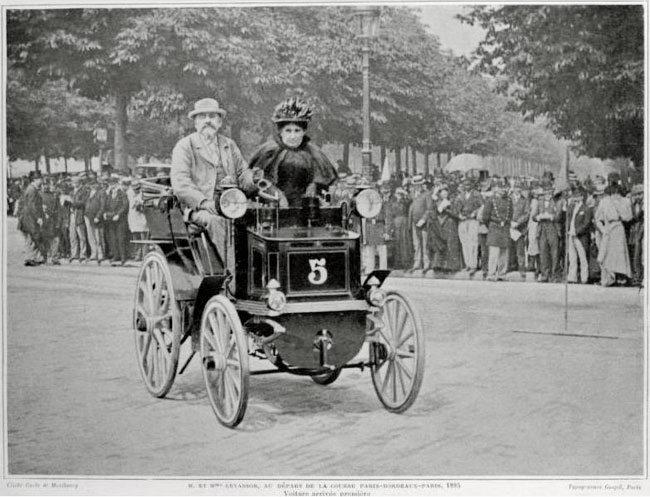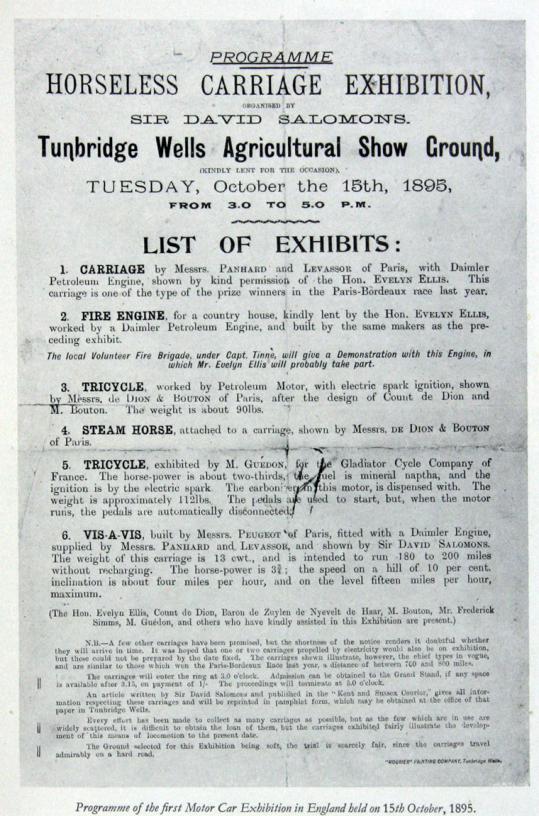It’s an import
The Honourable Evelyn Ellis of Datchet is credited as being the first person to drive a petrol driven car in Britain on the 4th or perhaps the 5th July 1895 when taking delivery of his imported French Panhard-Levassor 3¾hp powered by a Daimler engine.
On the journey from picking up the car at Micheldever railway station in Hampshire to his home in Datchet, his travelling companion, Frederick Simms, (who would become the sole English agent for the Daimler patents) noted that of the 133 horses they passed only “only two little ponies did not seem to appreciate the innovation.”
The first 56 miles, ever made by a “petroleum motor carriage” in the UK took 5 hours 32 minutes, excluding stops en route at an average speed of 9.84 mph whilst exceeding the countryside legal limit of 4mph.
A further six imported petrol driven cars drove the total in the UK to 7 by the end of 1895:
Sept 9th: Peugeot 3¾hp (French)
November: Roger-Benz 4hp French (under license)
21st Nov: Lutzmann 4hp (German)
Nov/Dec: 1895 Cannstatt-Daimler 3½hp (German)
Dec 1895: Benz ‘Velo’ 1½hp (German)
27th Dec: Panhard-Levassor 3¾hp (French)
Peugeot sold five cars in France in 1891 and the following year sold 29.
Benz having started vehicle production in 1893 sold his 2000th vehicle in 1889.

Émile Levassor and Louise Sarazin-Levassor at the start of the 1895 Paris-Bordeaux-Paris race, which Émile would win in 48 hrs and 48 minutes, but be disqualified for having a 2 seater, instead of a 4 seater despite his 5 hour 47 minute lead time averaging 24.54 km/h.
Two miles per hour
UK Locomotives on Highways Act 1865 and 1878
The speed limit of 4 mph in the countryside and 2 mph in the town and the necessity of a vehicle to be preceeded by a man walking was repealed in 1896 and the speed limit raised to 12 mph.
London to Brighton Run
Frederick Simms was instrumental in organising the celebration of the 14 mph speed limit a London to Brighton “Emancipation Run” consisting of 33 cars and a huge escort “10,000” of cyclists.
He also formed the Automobile Club of Great Britain in 1897.
There were very few people who had seen a car in 1896
14th November 1896: A wet Saturday
Amongst the 33 cars that set off were two American Duryea motor wagons (Springfield, Massachusetts) , one of which was the first to arrive of 17 vehicles that managed to complete the journey.
NB: The new speed limit of 14 mph applied to Light Vehicles (if under 3 tons unladen weight)
The Emancipation run is now known as the London to Brighton veteran car run.
1891 The first petrol driven vehicle in America was in Ohio city
1894 June 22nd Paris-Rouen 126km to be acheived within 8 1/2 hours. - 30 entrants
1895 June First real race: Paris - Bordeaux - Paris 1178km 732 miles - 30 entrants.
1895 November 28th Thanksgiving Race Chicago- Evanston, Illinois- Chicago 54.36 miles - 6 entrants
1899 Paris Bordeaux race - the first five cars were all Panhard & Levassor's - 28 car entrants
1903 Ford would import cars from the USA for the first time
Road going steam Carriages, never really took off as a long term investment, despite being capable of obtaining significant speeds and despite winning the 1894 78 mile Paris - Rouen car race.
The Manchester to Liverpool Railway was opened in 1830 followed by Birmingham to London in 1838 and London to Bristol in 1841.
When Steam powered railways arrived, that provided a smooth ride, there was no appetite for building roads for steam carriages.
